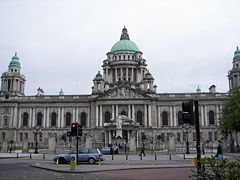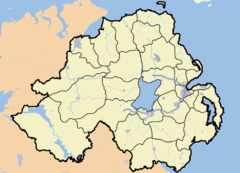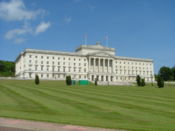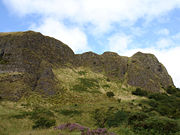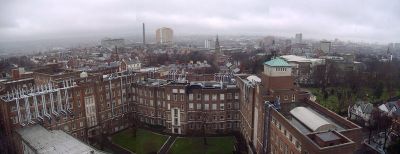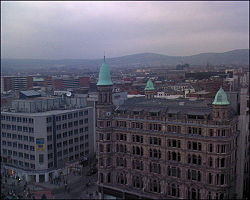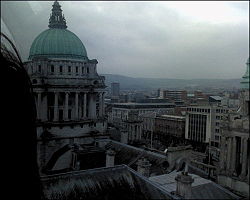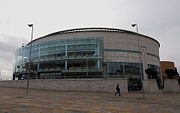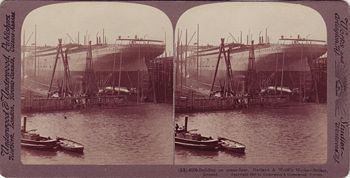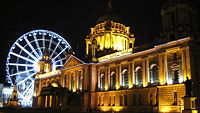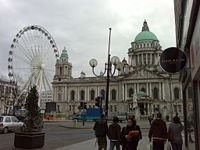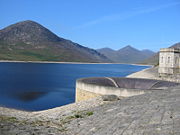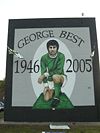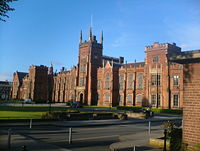Belfast
2008/9 Schools Wikipedia Selection. Related subjects: British Cities; Great Britain
| Belfast | |
| Scots: Bilfawst | |
| Irish: Béal Feirste | |
|
Belfast shown within Northern Ireland |
|
| Area | 44.4 sq mi (115 km²) |
|---|---|
| Population | City proper: 276,459 Belfast Metropolitan Area: 579,554 ( 2001 census) |
| Irish grid reference | |
| - London | 322 mi (518 km) SE |
| District | City of Belfast |
| County | County Antrim County Down |
| Constituent country | Northern Ireland |
| Sovereign state | United Kingdom |
| Post town | BELFAST |
| Postcode district | BT1-BT17, BT29 (part of), BT58 |
| Dialling code | 028 |
| Police | Northern Ireland |
| Fire | Northern Ireland |
| Ambulance | Northern Ireland |
| European Parliament | Northern Ireland |
| UK Parliament | Belfast North Belfast South Belfast East Belfast West |
| NI Assembly | Belfast North Belfast South Belfast East Belfast West |
| Website: www.belfastcity.gov.uk | |
| List of places: UK • Northern Ireland • | |
Coordinates:
Belfast (from the Irish: Béal Feirste meaning "Mouth of the (River) Farset") is the seat of government in Northern Ireland. It is the largest urban area in Northern Ireland and the province of Ulster and the second-largest city in Ireland.
The city suffered disruption, conflict, and destruction during The Troubles, but later underwent a period of calmness and growth.
History
Originally a town in County Antrim, the County borough of Belfast was created when it was granted city status by Queen Victoria in 1888.
Origins
The name, Belfast, is the anglicised version of the Irish Béal Feirste, which translates as "Mouth of the (River) Farset". This term refers to the sand bar that formed where the River Farset met the River Lagan at Donegall Quay and flowed into Belfast Lough, which became the hub around which the city developed.
The site of Belfast has been occupied since the Bronze Age. The Giant's Ring, a 5000-year-old henge, is located near the city, and the remains of Iron Age hill forts can still be seen in the surrounding hills. Belfast remained a small settlement of little importance during the Middle Ages. John de Courcy built a castle on what is now Castle Street in the city centre in the 12th century, but this was on a lesser scale and not as strategically important as Carrickfergus Castle to the north, which was built by de Courcy in 1177. The O'Neill clan had a presence in the area. In the 14th century the Clan Aedh Buidh, descendants of "Yellow" Hugh O'Neill built Grey Castle at Castlereagh, now in the east of the city. Conn O'Neill also owned land in the area, one remaining link being the Connswater River flowing thorough east Belfast.
Growth
Belfast became a substantial settlement in the 17th century after being established by Sir Arthur Chichester which was initially settled by the mainly Protestant English and Scottish migrants during the Plantation of Ulster.In 1791, the Society of United Irishmen was founded in Belfast, after Henry Joy McCracken and other prominent Presbyterians from the city invited Theobald Wolfe Tone and Thomas Russell to a meeting, after having read Tone's "Argument on Behalf of the Catholics of Ireland". Belfast blossomed as a commercial and industrial centre in the 18th and 19th centuries and became Ireland's pre-eminent industrial city. Industries thrived, including linen, rope-making, tobacco, heavy engineering and shipbuilding, and at the end of the nineteenth century, Belfast briefly overtook Dublin as the largest and most industrialised city in Ireland. The Harland and Wolff shipyards became one of the largest shipbuilders in the world, employing up to 35,000 workers. Belfast was heavily bombed during World War II. In one raid, in 1941, German bombers killed around one thousand people and left tens of thousands homeless. Outside of London, this was the greatest loss of life in a night raid during the Blitz.
The Troubles
Belfast has been the capital of Northern Ireland since its creation in 1920 by the Government of Ireland Act. Since it began to emerge as a major city, it has been the scene of much sectarian conflict between its Roman Catholic and Protestant populations. These opposing groups in this conflict are now often termed republican and loyalist respectively, although they are also referred to as ' nationalist' and ' unionist'. The most recent example of this is known as the Troubles - a civil conflict that raged from c.1969 to the late 1990s. Belfast saw the worst of the Troubles in Northern Ireland, particularly in the 1970s, with rival paramilitary groups forming on both sides. Bombing, assassination and street violence formed a backdrop to life throughout The Troubles. The IRA detonated 22 bombs, all in a confined area in the city centre in 1972, on what is known as " Bloody Friday", killing nine people. Loyalists paramilitaries, the Ulster Volunteer Force (UVF) and Ulster Defence Association (UDA) claimed that murders they carried out were in retaliaton to the PIRA campaign. Most of those their victims, however, were civilians entirely unconnected to the Provisional IRA. A particularly notorious group, based on the Shankill Road in the mid 1970s became known as the Shankill Butchers. In all, over 1,500 people were killed in political violence in the city from 1969 until 2001.
A legacy of the Troubles is that both republican and loyalist paramilitary groups in Belfast have become involved in organised crime and racketeering. On 20 December, 2004, UK£26.4 million was stolen from the headquarters of the Northern Bank in Belfast City Centre, the largest cash robbery at the time in the United Kingdom. The police investigation linked the robbery to the Provisional Irish Republican Army. Policing in Belfast is provided by the Police Service of Northern Ireland. They reported annual decreases in recorded crime in East, North, and South Belfast between 2002 and 2006. West Belfast showed an increase in recorded crime during the same period.
Governance
Belfast was granted borough status by James I in 1613 and official city status by Queen Victoria in 1888. Since 1971 it has been a local government district under local administration by Belfast City Council. Belfast is represented in both the British House of Commons and in the Northern Ireland Assembly. For elections to the European Parliament, Belfast is within the Northern Ireland constituency.
Local government
The city of Belfast has a mayoral form of municipal government. The City's officials are the Lord Mayor, Deputy Lord Mayor and High Sheriff who are elected from fifty-one councillors. The first Lord Mayor of Belfast was Daniel Dixon, who was elected in 1892. As of June 2008, the Lord Mayor of Belfast is Sinn Féin politician, Tom Hartley, who is only the second Sinn Féin Lord Mayor of the city. His duties, as mayor of Belfast, include presiding over meetings of the council, receiving distinguished visitors to the city, and representing and promoting the city on the national and international stage. Hartley replaces the Ulster Unionist Party Lord Mayor, Jim Rodgers OBE.
In 1997, Unionists lost overall control of Belfast City Council for the first time in its history, with the Alliance Party of Northern Ireland gaining the balance of power between Nationalists and Unionists. This position was confirmed in the council elections of 2001 and 2005. Since then it has had three Nationalist mayors, two from the Social Democratic and Labour Party (SDLP) and one from Sinn Féin. The first nationalist Lord Mayor of Belfast was Alban Maginness, a member of the Social Democratic and Labour Party, in 1996.
In the 2005 local government elections, the voters of Belfast elected fifty-one councillors to Belfast City Council from the following political parties: 15 Democratic Unionist Party (DUP), 14 Sinn Féin, 8 Social Democratic and Labour Party (SDLP), 7 Ulster Unionist Party (UUP), 4 Alliance Party, 2 Progressive Unionist Party (PUP), and 1 Independent.
Northern Ireland Assembly and Westminster
As Northern Ireland's capital city, Belfast is host to the Northern Ireland Assembly at Stormont, the site of home rule legislature in Northern Ireland. Belfast is divided into four Northern Ireland Assembly and UK parliamentary constituencies: North Belfast, West Belfast, South Belfast and East Belfast. All four extend beyond the city boundaries including into parts of Castlereagh, Lisburn and Newtownabbey districts. In the Northern Ireland Assembly Elections in 2007, Belfast elected 24 Members of the Legislative Assembly (MLAs), 6 from each constituency. The MLA breakdown consisted of 8 Sinn Féin, 6 Democratic Unionist Party (DUP), 4 Social Democratic and Labour Party (SDLP), 3 Ulster Unionist Party (UUP), 2 Alliance Party, and 1 Progressive Unionist Party (PUP). In the 2005 UK general election, Belfast elected one MP from each constituency to the House of Commons at Westminster, London. This was comprised of 2 DUP, 1 SDLP, and 1 Sinn Féin.
Coat of Arms and motto
The city of Belfast has the Latin motto "Pro tanto quid retribuamus". This is taken from Psalm 116 Verse 12 in the Latin Vulgate Bible and is literally "For (Pro) the much (tanto) it is that (quid) we repay (retribuamus)" The verse has been translated in different bibles differently - for example as "What shall I render unto the Lord for all his benefits toward me?". It is also translated as "In return for so much, what shall we give back?" The Queen's University Students' Union Rag Week publication PTQ derives its name from the first three words of the motto.
The city's coat of arms shows a central shield, bearing a ship and a bell, flanked by a chained wolf (or wolfhound) on the left and a seahorse on the right. A smaller seahorse sits at the top. This crest dates back to 1613, when King James I granted Belfast town status. The seal was used by Belfast merchants throughout the seventeenth century on their signs and trade-coins. A large stained glass window in the City Hall displays the seal, where an explanation suggests that the seahorse and the ship refer to Belfast's significant maritime history. The wolf may be a tribute to the city's founder, Sir Arthur Chichester, and refer to his own coat of arms.
Geography
Belfast is situated on Ireland's eastern coast at . The city is flanked to the northwest by a series of hills, including Cavehill, which is thought to be the inspiration for Jonathan Swift's novel, Gulliver's Travels. Belfast is located at the western end of Belfast Lough and at the mouth of the River Lagan making it an ideal location for the shipbuilding industry that once made it famous. When the Titanic was built in Belfast in 1912, Harland and Wolff had the largest shipyard in the world. Belfast is situated on Northern Ireland's eastern coast. A consequence of this northern latitude is that it both endures short winter days and enjoys long summer evenings. During the winter solstice, the shortest day of the year, local sunset is before 16:00 while sunrise is around 08:45. This is balanced by the summer solstice in June, when the sun sets after 22:00 and rises before 05:00.
Belfast is located at the eastern end of Belfast Lough and at the mouth of the River Lagan. In 1994, a weir was built across the river by the Laganside Corporation to raise the average water level so that it would cover the unseemly mud flats which gave Belfast its name(from the Irish: Béal Feirste meaning "The sandy ford at the river mouth"). The area of Belfast Local Government District is 42.3 square miles (110 km²).
The River Farset is also named after this silt deposit (from the Irish feirste meaning ‘sand spit’). Originally a more significant river than it is today, the Farset formed a dock on High Street until the mid 19th century. Bank Street in the city centre referred to the river bank and Bridge Street was named for the site of an early Farset bridge. However, superseded by the River Lagan as the more important river in the city, the Farset now languishes in obscurity, under High Street.
The city is flanked on the north and northwest by a series of hills, including Divis Mountain, Black Mountain and Cavehill thought to be the inspiration for Jonathan Swift's Gulliver's Travels. When Swift was living at Lilliput Cottage near the bottom of the Limestone Road in Belfast, he imagined that the Cavehill resembled the shape of a sleeping giant safeguarding the city. The shape of the giant's nose, known locally as Napoleon's Nose, is officially called McArt's Fort probably named after Art O'Neill, a sixteenth century chieftain who controlled the area at that time. The Castlereagh Hills overlook the city on the southeast.
Former poet and Catholic Bishop of Down and Connor, Dr William Philbin wrote this of Belfast: "Belfast is a city walled in by mountains, moated by sees, and undermined by deposits of history".
Climate
Belfast has a temperate climate. Average daily high temperatures are 18 °C (64 °F) in July and 6 °C (43 °F) in January. The highest temperature recorded in Belfast was 30.8 °C (87.4 °F) on 12 July 1983. The city gets significant precipitation (greater than 0.01 in/0.25 mm) on 213 days in an average year with an average annual rainfall of 845.8 millimetres (33.3 in), less than the Lake District or the Scottish Highlands, but higher than Dublin or the south-east coast of Ireland. As an urban and coastal area, Belfast typically gets snow on fewer than 10 days per year. The city is also renowned for how warm it can get during the winter month at its high latitude. In February, temperatures have hit 17 °C, at the same latitude where it is ~-45 °C in Russia and Canada. It is not uncommon for temperatures in summer to reach as high as 27 °C (80 °F) on numerous days. The consistently humid climate that prevails over Ireland can make temperatures feel uncomfortable when they stray into the high 20s (80-85°F), more so than similar temperatures in hotter climates in the rest of Europe.
| Weather averages for Belfast, Northern Ireland, United Kingdom | |||||||||||||
|---|---|---|---|---|---|---|---|---|---|---|---|---|---|
| Month | Jan | Feb | Mar | Apr | May | Jun | Jul | Aug | Sep | Oct | Nov | Dec | Year |
| Record high °C (°F) | 13 (55) | 14 (57) | 19 (66) | 21 (70) | 26 (79) | 28 (82) | 32 (90) | 28 (82) | 26 (79) | 21 (70) | 16 (61) | 14 (57) | 32 (90) |
| Average high °C (°F) | 6 (43) | 7 (45) | 9 (48) | 12 (54) | 15 (59) | 18 (64) | 18 (64) | 18 (64) | 16 (61) | 13 (55) | 9 (48) | 7 (45) | 12 (54) |
| Average low °C (°F) | 2 (36) | 2 (36) | 3 (37) | 4 (39) | 6 (43) | 9 (48) | 11 (52) | 11 (52) | 9 (48) | 7 (45) | 4 (39) | 3 (37) | 6 (43) |
| Record low °C (°F) | -13 (9) | -12 (10) | -12 (10) | -4 (25) | -3 (27) | -1 (30) | 4 (39) | 1 (34) | -2 (28) | -4 (25) | -6 (21) | -11 (12) | -13 (9) |
| Precipitation mm (inches) | 80 (3.15) | 52 (2.05) | 50 (1.97) | 48 (1.89) | 52 (2.05) | 68 (2.68) | 94 (3.7) | 77 (3.03) | 80 (3.15) | 83 (3.27) | 72 (2.83) | 90 (3.54) | 846 (33.31) |
| Source: 2007-08-04 | |||||||||||||
Areas and districts
Belfast expanded very rapidly from a small market town to an industrial city during the course of the nineteenth century. Because of this, it is less an agglomeration of villages and towns which have expanded into each other, than other comparable cities, such as Manchester or Birmingham. The city expanded to the natural barrier of the hills that surround it, overwhelming other settlements. Consequently the arterial roads along which this expansion took place (such as the Falls Road or the Newtownards Road) are more significant in defining the districts of the city than nucleated settlements. Including the City Centre, the city can be divided into five areas with North Belfast, East Belfast, South Belfast, and West Belfast. Each of these is a parliamentary constituency. Belfast remains segregated by walls, commonly known as “ peace lines”, erected by the British Army after August 1969, which still divide fourteen neighbourhoods in the inner-city. In June 2007, a UK£16 million programme was announced which will transform and redevelop streets and public spaces in the city centre. Major arterial roads ( quality bus corridors) into the city include the Antrim Road, Shore Road, Holywood Road, Newtownards Road, Castlereagh Road, Cregagh Road, Ormeau Road, Malone Road, Lisburn Road, Falls Road, Springfield Road, Shankill Road, and Crumlin Road.
Belfast City Centre is divided by two postcodes, BT1 for the area lying north of the City Hall, and BT2 for the area to its south. The industrial estate and docklands share BT3. The rest of the Greater Belfast postcodes are set out in a clockwise system. Although BT stands for Belfast, it is used across the whole of Northern Ireland.
Since 2001, boosted by increasing numbers of tourists, the city council has developed a number of cultural quarters. The Cathedral Quarter takes its name from St. Anne’s Cathedral (Church of Ireland) and has taken on the mantle of the city's key cultural locality. It hosts a yearly visual and performing arts festival.
In March 2008, Victoria Square, Belfast, a £400m shopping complex opened in the centre of Belfast, consisting of shops, restaurants, a cinema (opening in June 2008) and the largest House of Fraser in the UK and Ireland, increasing the shopping area of Belfast by up to a third.
Custom House Square is one of the city's main outdoor venues for free concerts and street entertainment. The Gaeltacht Quarter is an area around the Falls Road in West Belfast which promotes and encourages the use of the Irish language. The Queen's Quarter in South Belfast is named after Queen's University. The area has a large student population and hosts the annual Belfast Festival at Queen’s each autumn. It is home to Botanic Gardens and the Ulster Museum, closed for major redevelopment until 2009. The Golden Mile is the name given to the mile between Belfast City Hall and Queen's University. Taking in Gt. Victoria St, Shaftesbury Square and Bradbury Place, it contains some of the best bars and restaurants in the city. Since the Good Friday Agreement in 1998, the nearby Lisburn Road has developed into the city's most exclusive shopping strip. Finally, The Titanic Quarter covers 0.75 km² of reclaimed land adjacent to Belfast harbour, formerly known as Queen's Island. Named after the Titanic, which was built here in 1912, work has begun which promises to transform some former shipyard land into "one of the largest waterfront developments in Europe". Plans also include apartments, a riverside entertainment district, and a major Titanic-themed museum.
Parks and gardens
Belfast has over forty public parks. The Forest of Belfast is a partnership between government and local groups, set up in 1992 to manage and conserve the city's parks and open spaces. They have commissioned more than 30 public sculptures since 1993. In 2006, the City Council set aside UK£8 million to continue this work. The Belfast Naturalists' Field Club was founded in 1863 and is administered by National Museums and Galleries of Northern Ireland.
With 700,000 visitors in 2005, one of the most popular parks is Botanic Gardens in the Queen's Quarter. Built in the 1830s and designed by Sir Charles Lanyon, Botanic Gardens Palm House is one of the earliest examples of a curvilinear and cast iron glasshouse. Other attractions in the park include the Tropical Ravine, a humid jungle glen built in 1889, rose gardens and public events ranging from live opera broadcasts to pop concerts. U2 played here in 1997 and the Tennents ViTal festival takes place in the gardens each summer. Sir Thomas and Lady Dixon Park, to the south of the city centre, attracts thousands of visitors each year to its International Rose Garden. Rose Week in July each year features over 20,000 blooms. It has an area of 128 acres (0.52 km²) of meadows, woodland and gardens and features a Princess Diana Memorial Garden, a Japanese Garden, a walled garden, and the Golden Crown Fountain commissioned in 2002 as part of the Queen’s Golden Jubilee celebrations.
In 2008, Belast was named a finalist in the Large City (200,001 and over) category of the RHS Britain in Bloom competition along with London Borough of Croydon and Sheffield.
Demography
| Northern Ireland 2001 census | ||
| Belfast | Northern Ireland | |
| Protestant | 49% | 53% |
| Roman Catholic | 47% | 44% |
| Male | 47% | 49% |
| Under 16 years old | 22% | 24% |
| Between 20 and 44 years old | 37% | 37% |
| Over 65 years old | 15% | 13% |
| Ethnically white | 99% | 99% |
In the 2001 census, the population within the city limits (the Belfast Urban Area) was 276,459, while 579,554 people lived in the wider Belfast Metropolitan Area. This made it the fifteenth-largest city in the United Kingdom, but the eleventh-largest conurbation. Belfast experienced a huge growth in population around the first half of the twentieth century. This rise slowed and peaked around the start of the Troubles with the 1971 census showing almost 600,000 people in the Belfast Urban Area. Since then, the inner city numbers have dropped dramatically as people have moved to swell the Greater Belfast suburb population. The 2001 census population within the same Urban Area, had fallen to 277,391 people, with 579,554 people living in the wider Belfast Metropolitan Area. The population density in the same year was 2,415 people/km² (compared to 119 for the rest of Northern Ireland). As with many cities, Belfast's inner city is currently characterised by the elderly, students and single young people, while families tend to live on the periphery. Socio-economic areas radiate out from the Central Business District, with a pronounced wedge of affluence extending out the Malone Road to the south. An area of greater deprivation extends to the west of the city. The areas around the Falls and Shankill Roads are the most deprived wards in Northern Ireland.
Despite a period of relative peace, most areas and districts of Belfast still reflect the divided nature of Northern Ireland as a whole. Many areas are still highly segregated along ethnic, political and religious lines, especially in working class neighbourhoods. These zones ‘Catholic’ or ‘ Protestant’, ‘ Republican’ or ‘ Loyalist’ are invariably marked by flags, graffiti and murals. Segregation has been present throughout the history of Belfast, but has been maintained and increased by each outbreak of violence in the city. This escalation in segregation, described as a "ratchet effect", has shown little sign of decreasing during times of peace. When violence flares, it tends to be in interface areas. The highest levels of segregation in the city are in West Belfast with many areas greater than 90% Catholic. Opposite but comparatively high levels are seen in the predominantly Protestant East Belfast. Areas where segregated working-class areas meet are known as interface areas.
Ethnic minority communities have been in Belfast since the 1930s. The largest groups are Chinese and Irish travellers. Since the expansion of the European Union, numbers have been boosted by an influx of Eastern European immigrants. Census figures (2001) showed that Belfast has a total ethnic minority population of 4,584 or 1.3% of the population. Over half of these live in South Belfast with numbers reaching 2.63% of the population. The majority of the estimated 5000 Muslims and 200 Hindu families living and working in Northern Ireland live in the Greater Belfast area.
Economy
The IRA Ceasefire in 1994 and the signing of the Good Friday Agreement in 1998 have given investors increased confidence to invest in Belfast. This has led to a period of sustained economic growth and large-scale redevelopment of the city centre. Developments include Victoria Square, the Cathedral Quarter, and the Laganside with the Odyssey complex and the landmark Waterfront Hall.
Other major developments include the regeneration of the Titanic Quarter, and the erection of the Obel Tower, a skyscraper set to be the tallest tower on the island until eclipsed by the U2 Tower in Dublin. In 2007, Belfast launched its vision for a World Trade Centre—currently a 'virtual' centre but with plans to become a physical building—which aims to promote the city to the international business market.
Today, Belfast is Northern Ireland's educational and commercial hub. In February 2006, Belfast's unemployment rate stood at 4.2%, lower than both the Northern Ireland and the UK average of 5.5%. Over the past 10 years employment has grown by 16.4 per cent, compared with 9.2 per cent for the UK as a whole.
Northern Ireland's peace dividend has led to soaring property prices in the city. In 2007, Belfast saw house prices grow by 50%, the fastest rate of growth in the UK. In March 2007, the average house in Belfast cost £191,819, with the average in South Belfast being £241,000. In 2004, Belfast had the lowest owner occupation rate in Northern Ireland at 54%.
Peace has also boosted the numbers of tourists coming to Belfast. There were 6.4 million visitors in 2005, which was a growth of 8.5% from 2004. The visitors spent £285.2 million, supporting more than 15,600 jobs. Visitor numbers rose by 6% to reach 6.8 million in 2006, with tourists spending £324 million, an increase of 15% on 2005. The city's two airports have help make the city one of the most visited weekend destinations in Europe.
Industrial growth
When the population of Belfast town began to grow in the seventeenth century, its economy was built on commerce. It provided a market for the surrounding countryside and the natural inlet of Belfast Lough gave the city its own port. The port supplied an avenue for trade with Great Britain and later Europe and North America. In the mid-seventeenth century, Belfast exported beef, butter, hides, tallow and corn and it imported coal, cloth, wine, brandy, paper, timber and tobacco. Around this time, the linen trade in Northern Ireland blossomed and by the middle of the eighteenth century, one fifth of all the linen exported from Ireland was shipped from Belfast. The present city however is a product of the Industrial Revolution. It was not until industry transformed the linen and shipbuilding trades that the economy and the population boomed. By the turn of the nineteenth century, Belfast had transformed into the largest linen producing centre in the world, earning the nickname "Linenopolis".
Belfast harbour was dredged in 1845 to provide deeper berths for larger ships. Donegall Quay was built out into the river as the harbour was developed further and trade flourished. The Harland and Wolff shipbuilding firm was created in 1861, and by the time the Titanic was built in Belfast in 1912 it had become the largest shipyard in the world.
Short Brothers plc is a British aerospace company based in Belfast. It was the first aircraft manufacturing company in the world. The company began its association with Belfast in 1936, with Short & Harland Ltd, a venture jointly owned by Shorts and Harland and Wolff. Now known as Shorts Bombardier it works as an international aircraft manufacturer located near the Port of Belfast. The rise of mass-produced and cotton clothing following World War I were some of the factors which led to the decline of Belfast's international linen trade. Like many British cities dependent on traditional heavy industry, Belfast suffered serious decline since the 1960s, exacerbated greatly in the 1970s and 1980s by The Troubles. More than 100,000 manufacturing jobs have been lost since the 1970s. For several decades, Northern Ireland's fragile economy required significant public support from the British exchequer of up to UK£4 billion per year. Ongoing sectarian violence has made it difficult for Belfast to compete with Dublin's Celtic Tiger economy.
Architecture
The architectural style of Belfast's buildings range from Edwardian, like the City Hall, to modern, like Waterfront Hall. Many of the city's Victorian landmarks, including the main Lanyon Building at Queen's University Belfast and the Linenhall Library, were designed by Sir Charles Lanyon.
The City Hall was finished in 1906 and was built to reflect Belfast’s city status, granted by Queen Victoria in 1888. The Edwardian architectural influenced the Victoria Memorial in Calcutta, India, and Durban City Hall in South Africa. The dome is 173 ft (53 m) high and figures above the door state “ Hibernia encouraging and promoting the Commerce and Arts of the City”. Among the city's grandest buildings are two former banks: Ulster Bank in Waring Street (built in 1860) and Northern Bank, in nearby Donegall Street (built in 1769). The Royal Courts of Justice in Chichester Street are home to Northern Ireland's Supreme Court. Many of Belfast's oldest buildings are found in the Cathedral Quarter area, which is currently undergoing redevelopment as the city's main cultural and tourist area. Windsor House, 262 ft (80 m) high, has twenty-three floors and is the tallest building (as distinct from structure) in Ireland. Work has started on the taller Obel Tower and in 2007, plans were approved for the Aurora building. At 37 storeys and 358 ft (109 m) high, this will surpass both previous buildings.
The ornately decorated Crown Liquor Saloon, designed by Joseph Anderson 1876, in Great Victoria Street is the only bar in the UK owned by the National Trust. It was made internationally famous as the setting for the classic film, Odd Man Out, starring James Mason. The restaurant panels in the Crown Bar were originally made for Britannic, the sister ship of the Titanic, built in Belfast. The Harland and Wolff shipyard is now the location of the world's largest dry dock, where the giant cranes, Samson and Goliath stand out against Belfast's skyline. Including the Waterfront Hall and the Odyssey Arena, Belfast has several other venues for performing arts. The architecture of the Grand Opera House has a distinctly oriental theme and was completed in 1895. It was bombed several times during the Troubles but has now been restored to its former glory. The Lyric Theatre, the only full-time producing theatre in the country, is where film star Liam Neeson began his career. The Ulster Hall (1859-1862) was originally designed for grand dances but is now used primarily as a concert and sporting venue. Lloyd George, Parnell and Patrick Pearse all attended political rallies there.
Infrastructure
Belfast saw the worst of The Troubles in Ireland, with nearly half of the total deaths in the conflict occurring in the city. However, since the Good Friday Agreement in 1998, there has been significant urban regeneration in the city centre including Victoria Square, Queen's Island and Laganside as well as the Odyssey complex and the landmark Waterfront Hall. The city is served by two airports: The George Best Belfast City Airport adjacent to Belfast Lough and Belfast International Airport which is near Lough Neagh. Queen's University of Belfast is the main university in the city. The University of Ulster also maintains a campus in the city, which concentrates on fine art, design and architecture.
Belfast is one of the constituent cities that makes up the Dublin-Belfast corridor region, which has a population of just under 3 million.
Utilities
Most of Belfast's water is supplied from the Silent Valley Reservoir in County Down, created to collect water from the Mourne Mountains. The rest of the city's water is sourced from Lough Neagh, via Dunore Water Treatment Works in County Antrim. The citizens of Belfast pay for their water in their rates bill. Plans to bring in additional water tariffs have been deferred by devolution in May 2007. Belfast has approximately 1,300 km of sewers, which are currently being replaced in a project costing over UK£100 million and due for completion in 2009.
Northern Ireland Electricity is responsible for transmitting electricity in Northern Ireland. Belfast's electricity comes from Kilroot Power Station, a 520 megawatt dual coal and oil fired plant, situated near Carrickfergus. Phoenix Natural Gas Ltd. has been granted the licence for the transportation of natural gas across the Irish Sea from Stranraer to supply Greater Belfast from a base station near Carrickfergus. Rates in Belfast (and the rest of Northern Ireland) were reformed in April 2007. The discrete capital value system means rates bills are determined by the capital value of each domestic property as assessed by the Valuation and Lands Agency. The recent dramatic rise in house prices has made these reforms unpopular.
Health Care
The Belfast Trust is one of five NHS trusts which were created on 1 April 2007 by the Department of Health. Belfast contains most of Northern Ireland's regional specialist centres. The Royal Victoria Hospital, serving mainly West Belfast, is an internationally renowned centre of excellence in trauma care and provides specialist trauma care for all of Northern Ireland. It also provides the city's specialist neurosurgical, ophthalmology, ENT, and Dentistry services. The City Hospital, serving South Belfast, is the regional specialist centre for Haematology and is home to the most modern equipped regional Cancer Centre in the UK. The Mary G McGeown Regional Nephrology Unit at the Belfast City Hospital is the Kidney Transplant Centre and provides regional renal services for N.Ireland. Musgrave Park Hospital in South Belfast specialises in orthopaedics, rheumatology, sports medicine and rehabilitation. It is home to Northern Ireland's first Acquired Brain Injury Unit, costing GB£9 million and opened by the Prince of Wales and the Duchess of Cornwall in May, 2006. Other hospitals in Belfast include the Mater Hospital in North Belfast, the Children's Hospital, and the Ulster Hospital, Dundonald.
Transportation
Belfast is a relatively car-dependent city, by European standards, with an extensive road network including the ten lane M2 motorway. A recent survey of how people travel in Northern Ireland showed that people in Belfast made 77% of all journeys by car, 11% by public transport and 6% on foot. It also showed that Belfast has 0.70 cars per household compared to figures of 1.18 in the East and 1.14 in the West of Northern Ireland. A significant road improvement scheme in Belfast began early in 2006, with the upgrading of two junctions along the Westlink dual carriageway to grade separated standard. The Westlink, a dual carriageway skirting the western edge of the City Centre, connects all three Belfast motorways and often suffers from chronic congestion. The work will cost UK£103.9 million and is scheduled for completion in 2009. Commentators have argued that this may simply create a bottleneck at York Street, the next at-grade intersection, until that too is upgraded (planned for 2011).
Black taxis are common in the city, operating on a share basis in some areas. However, these are outnumbered by private hire minicabs. Bus and rail public transport in Northern Ireland is operated by subsidiaries of Translink. Bus services in the city proper and the nearer suburbs are operated by Translink Metro, with services focusing on linking residential districts with the City Centre on twelve quality bus corridors running along main radial roads, resulting in poor connections between different suburban areas. More distant suburbs are served by Ulsterbus. Northern Ireland Railways provides suburban services along three lines running through Belfast’s northern suburbs to Carrickfergus and Larne, eastwards towards Bangor and south-westwards towards Lisburn and Portadown. This service is known as the Belfast Suburban Rail system. Belfast also has a direct rail connection with Dublin called Enterprise which is operated jointly by NIR and Iarnród Éireann, the state railway company of the Republic of Ireland. In April 2008 the DRD reported on a plan for a light rail system, similar to Dublin's system, suggesting that investment in more modern buses would be prefereable.
The city has two airports: the Belfast International Airport offers domestic, European and transatlantic flights and is located north of the city, near Lough Neagh, while the George Best Belfast City Airport is closer to the city centre, adjacent to Belfast Lough. In 2005, Belfast International Airport was the 11th busiest commercial airport in the UK, accounting for just over 2% of all UK terminal passengers while the George Best Belfast City Airport was the 16th busiest and had 1% of UK terminal passengers.
Belfast has a large port which is used for exporting and importing goods, and for passenger ferry services. Stena Line run regular routes to Stranraer in Scotland using their HSS (High Speed Service) vessel—with a crossing time of around 90 minutes—and/or their conventional vessel—with a crossing time of around 3hrs 45 minutes. Norfolkline—formally Norse Merchant Ferries—run a passenger/cargo ferry to and from Liverpool, with a crossing time of 8 hours and a seasonal sailing to Douglas, Isle of Man is operated by the Isle of Man Steam Packet company—formally SeaCat.
Culture
Belfast's population is evenly split between its Protestant and Catholic residents (politically Unionist and Nationalist respectively). These two distinct vibrant cultural communities have both contributed significantly to the city's culture. Throughout the Troubles, Belfast artists continued to express themselves through poetry, art and music. In the period since the Good Friday Agreement in 1998, Belfast has begun a social, economic and cultural transformation giving it a growing international cultural reputation. In 2003, Belfast had an unsuccessful bid for the 2008 European Capital of Culture. The bid was run by an independent company, Imagine Belfast, who boasted that it would "make Belfast the meeting place of Europe's legends, where the meaning of history and belief find a home and a sanctuary from caricature, parody and oblivion." According to The Guardian the bid may have been undermined by the city's history and volatile politics.
In 2004-05, art and cultural events in Belfast were attended by 1.8 million people (400,000 more than the previous year). The same year, 80,000 people participated in culture and arts activities, twice as many as in 2003-04. A combination of relative peace, international investment and an active promotion of arts and culture is attracting more tourists to Belfast than ever before. In 2004-05, 5.9 million people visited Belfast, a 10% increase from the previous year, and spent UK£262.5 million.
The Ulster Orchestra, based in Belfast, is Northern Ireland's only full-time symphony orchestra and is well renowned in the United Kingdom. Founded in 1966, it has existed in its present form since 1981, when the BBC Northern Ireland Orchestra was disbanded.
Sports
Watching and playing sports is an important part of Belfast culture. Almost six out of ten (59%) of the adult population in Northern Ireland regularly participate in one or more sports. Belfast has several notable sports teams playing a diverse variety of sports including association football, rugby, Gaelic games, and North American sports like American football and ice hockey. The Belfast Marathon is run annually on May Day, and attracted 14,300 participants in 2007. The Northern Ireland national football team, ranked 27th in September 2007 in the FIFA World Rankings, and 1st in the FIFA rankings per capita in April 2007 play their home matches in Windsor Park. The 2005-06 Irish League champions Linfield are also based at Windsor Park, in the south of the city. Other Premier League teams include Glentoran based in east Belfast, Cliftonville and Crusaders in north Belfast and Donegal Celtic in west Belfast. Belfast was the hometown of the renowned player George Best who died in November 2005. On the day he was buried in the city, 100,000 people lined the route from his home on the Cregagh Road to Roselawn cemetery. Since his death the City Airport was named after him and a trust has been set up to fund a memorial to him in the city centre.
Gaelic football is the most popular spectator sport in Ireland, and Belfast is home to over 20 football and hurling clubs. Casement Park in West Belfast, home to the Antrim county teams, has a capacity of 32,000 which makes it the second largest Gaelic Athletic Association ground in Ulster. The 2006 Celtic League champions and 1999 European Rugby Union champions Ulster play at Ravenhill in South Belfast. Belfast has four teams in rugby's All-Ireland League: Belfast Harlequins (who play at Deramore Park in south Belfast) and Malone (who play at Gibson Park in south-east Belfast) are in the Second Division; and Instonians (Shaw's Bridge, south Belfast) and Queen's University RFC (south Belfast) are in the Third Division.
Belfast boasts Ireland's premier cricket venue at Stormont. The Ireland cricket team plays many of its home games at this venue, which in 2006 hosted the first ever One Day International between Ireland and England. In 2007, Ireland, India and South Africa will play a triangular series of one-day internationals at Stormont. At club level, Belfast has seven senior teams: Instonians (Shaw's Bridge, south Belfast) and Civil Service North (Stormont, east Belfast) are in Section 1 of the Northern Cricket Union League; CIYMS (Circular Road, east Belfast), Cooke Collegians (Shaw's Bridge) and Woodvale (Ballygomartin Road, west Belfast) are in Section 2; and Cregagh (Gibson Park, south-east Belfast) and Police Service of Northern Ireland (Newforge Lane, south Belfast) are in Section 4.
Ireland's first professional ice hockey team, the Belfast Giants play their home matches at the Odyssey Arena, watched by up to 7,000 fans. The Belfast Bulls and Belfast Trojans American football teams represent Belfast in the IAFL, competing for the Shamrock Bowl. Other significant sportspeople from Belfast include double world snooker champion Alex "Hurricane" Higgins and world champion boxers Wayne McCullough and Rinty Monaghan.
Education
Belfast has two universities. Queen's University Belfast was founded in 1845 and is a member of the Russell Group, an association of 20 leading research-intensive universities in the UK. It is one of the largest universities in the UK with 25,231 undergraduate and postgraduate students spread over 250 buildings, 120 of which are listed as being of architectural merit. The University of Ulster, created in its current form in 1984, is a multi-centre university with a campus in the Cathedral Quarter of Belfast. The Belfast campus has a specific focus on Art and Design and Architecture, and is currently undergoing major redevelopment. The Jordanstown campus, just seven miles (11 km) from Belfast city centre concentrates on engineering, health and social science. The Conflict Archive on the INternet (CAIN) Web Service receives funding from both universities and is a rich source of information and source material on the Troubles as well as society and politics in Northern Ireland.
Belfast Metropolitan College is a large further education college with several campuses around the city. Formerly known as Belfast Institute of Further and Higher Education, it specialises in vocational education. The college has over 53,000 students enrolled on full-time and part-time courses, making it one of the largest further education colleges in the UK.
The Belfast Education and Library Board was established in 1973 as the local authority responsible for education, youth and library services within the city. There are 184 primary, secondary and grammar schools in the city.
Ulster Museum is also located in Belfast.
Flora and Fauna
Twin cities
Belfast is twinned with:
 Nashville, Tennessee, United States
Nashville, Tennessee, United States Belfast, Maine, United States
Belfast, Maine, United States Bonn, Germany
Bonn, Germany Hefei, China
Hefei, China
